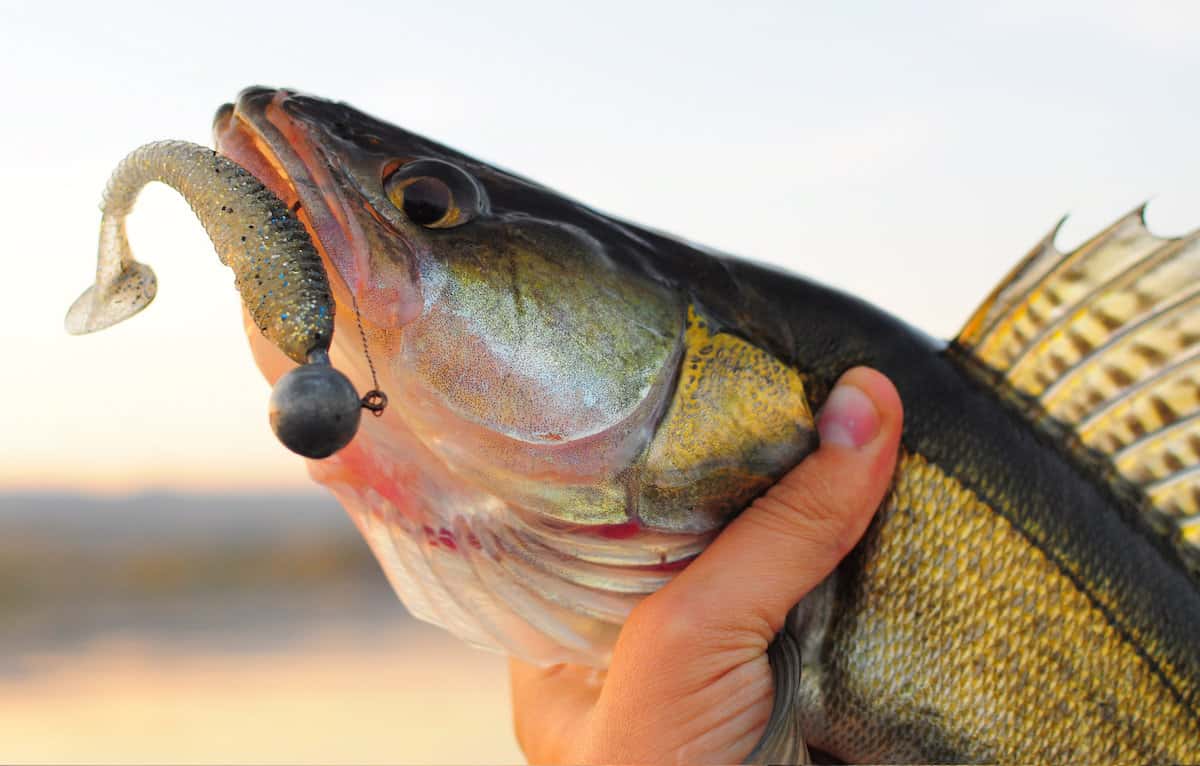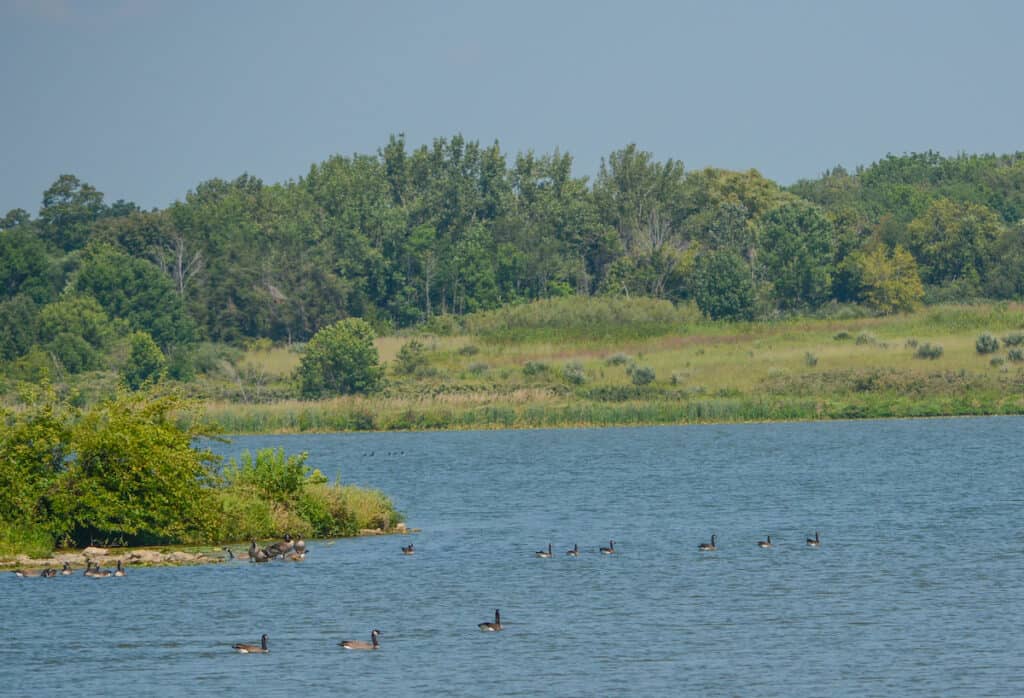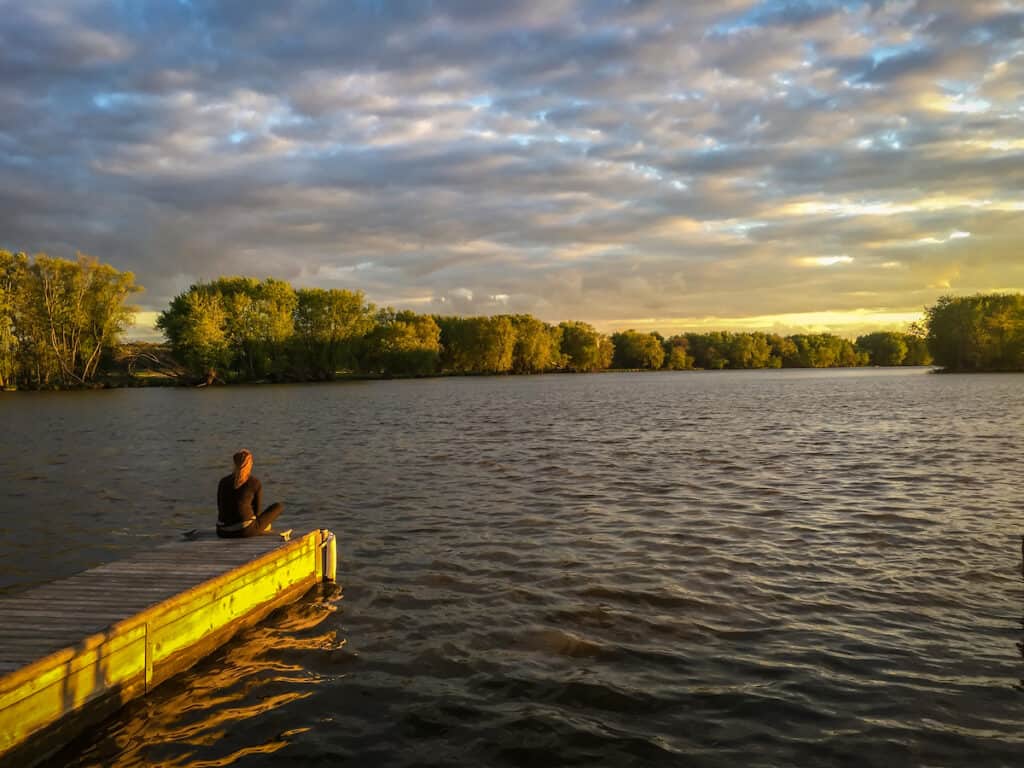You might hear a running joke among Illinois anglers that the arrival of walleye season means it’s time to pack up your rod and head to Wisconsin. But that old line runs the risk of selling Illinois’ walleye fishery short.
Though Illinois might not be the first state most anglers think of for walleye fishing, the Land of Lincoln offers some surprisingly impressive walleye options.
Most, but not all, of the best walleye lakes in Illinois are clustered in the northern tier of the state, where glaciers left the landscape dotted with natural lakes. But there are quality walleye options statewide, including major reservoirs and many of Illinois’ major rivers.
Walleye fishing in Illinois typically peaks in spring—these fish typically spawn during April in most Illinois waters—but can also be excellent on summer evenings and during fall months. The best bite is often after dark.
And don’t be surprised if you catch a fish that looks like a walleye but isn’t quite a walleye. Sauger, closely related and visually similar, are also common in many Illinois waters.
Best Walleye Lakes in Illinois
Fox Chain O’ Lakes
If Illinois has anything that could be called a bona fide walleye factory, it’s the Fox Chain O’ Lakes. That bold statement is almost literally true, as the DNR manages the Fox Chain as the walleye broodstock source for the state hatchery system.
Located a stone’s throw from the Wisconsin border in Northeast Illinois, the Fox Chain O’ Lakes consists of 15 interconnected glacial lakes that cover about 7,110 acres in total size. They’re almost certainly the most well-known walleye lakes in the state, and the fishing pressure reflects that.
Oddly enough, the fishing pressure doesn’t seem to negatively affect the fishing. Perhaps the walleye here have grown so acclimated to the sounds of fishing boats that they bite readily in almost any conditions.
They’re also known to behave in unusual ways in the Fox Chain, and anglers use some unconventional methods to catch them. Walleye are almost always caught in less than 10 feet of water here. They may also be just a few feet off the banks, especially in spring.
Target shallow rocks and gravel-bottomed areas with crankbaits, curlytail grubs, and jigs tipped with minnows or nightcrawlers along windblown shores.
The southeast shoreline of Channel Lake and the flats surrounding Lake Marie’s major point are reliably productive in April.
Bridges, narrows and bottlenecks between the various lakes are good areas to try in any season. For example, the Route 12 bridge between Pistakee and Neppersink lakes is a perennial hotspot.
Edges of weed beds also start to become key areas as they develop in summer.
The best time of day to catch walleye is just before sunrise to early morning.
The spring walleye bite often coincides with some excellent crappie fishing, so many anglers switch gears and start catching crappies once the sun is up.
Access is available at multiple locations, including Chain O’ Lakes State Park.
The Fox Chain has a slot limit that requires all walleye between 18″ and 24″ to be released.
East Fork Lake
One of the best walleye lakes in Southern Illinois, East Fork Lake is a 935-acre reservoir in Richland County, just outside Olney.
With moderate clarity, depths up to 38 feet, and a wide range of hard bottom structure, it’s an ideal place for walleye to thrive.
And thrive they do. The DNR has been stocking between 30,000 and 50,000 walleye fingerlings annually for decades, and anglers can catch fish from multiple year classes at any given time.
Recent surveys found that the overwhelming majority of adult walleye in East Fork lake are over the 14″ legal length limit, and plenty of 2- to 5-pound ‘eyes are available.
Perhaps best of all, most anglers come here to target bass and crappie, leaving walleye relatively unpressured.
In spring, there’s great walleye action along the riprap face of the dam. There is also a submerged culvert in the northeast arm of the lake that provides prime walleye structure, and anglers also catch a lot of fish along the N. St. Marie Road crossings.
East Fork Lake also has a lot of steep main lake points, and the best summer walleye bite is usually right along windblown points just as the sun goes down.
Try anchoring offshore and casting toward the bank with a jighead or Lindy Rig baited with a nightcrawler or leech, and dragging it slowly down the point.
The primary access to East Fork Lake is through Rotary Park, which offers bank fishing access and boat ramps with ample parking for vehicles and trailers. Anglers can also bank fish along the dam.
Shabbona Lake
A little over an hour west of Chicago in DeKalb County, this reservoir is consistently one of the best walleye lakes in Illinois despite spanning a modest 316 acres.
Shabbona Lake is known for both size and numbers of walleye. Individuals over 10 pounds have been caught here, and walleye over 18 inches are common. State-record-caliber walleye are rumored to lurk in Shabbona’s depths.
Catching walleye can be tricky because the lake—being completely surrounded by Shabbona Lake State Park—closes every day around dark (precise hours vary by season, the latest being 10 p.m. from April 1 to October 31).
Another challenge is that walleye in Shabbona Lake are well-fed by the ample natural forage and have a broad array of perfect habitat to choose. Mind you, this is not the worst problem to have.
One of the best places to target walleye is along the old roadbed that spans the bottom of the lake. An assortment of brush, cribs and rock piles have also been placed on or around the roadbed over the years, giving walleye plenty of locations to set up shop.
Walleye also hang out along the old creek channel, near the dam, among the lake’s standing timber, and around various rock piles.
The best tactic is to present live bait close to the bottom, as walleye here are often unwilling to chase a lure or move too far for a meal.
More: Complete Guide to Shabbona Lake Fishing
Best Walleye Rivers in Illinois
Mississippi River
The Mississippi River forms Illinois’ entire 593-mile western border. It’s an outstanding walleye river and an even better sauger river. Sauger outnumber walleye in most pools, and many measure over 16 inches and weigh over 2 pounds.
Dams along the Mississippi break up the river into a series of pools, which are numbered 12 through 26 from the Wisconsin state line down to the confluence of the Illinois River. As a general rule, the farther upriver you go, the better the walleye and sauger fishing gets.
Below Pool 21 or so, walleye are less common, and the Mississippi River is dominated more by catfish. Unsurprisingly, the tailrace areas below each dam provide some of the best fishing.
Pool 12, the uppermost portion of the river in Illinois, offers some excellent options. The East Dubuque Public Boat Ramp and adjacent beach provide river access to Pool 12, and there are also several marinas in the area.
There is also great walleye fishing below Lock and Dam 12, though this area is easier to reach on the Iowa side, where the city of Bellevue provides excellent public access.
Walleye and sauger typically hold immediately downstream of any current break, or along current seams. Therefore, wing dams are key structures to look for in various parts of the Mississippi River, especially the upper pools.
Wing dams, many of which were built as far back as the 1800s, are rocky structures that extend partway into the river. Built as early attempts to control the Mississippi’s flow, they now offer prime structure for walleye, smallmouth bass, and other game fish.
Some wing dams are visible above the surface, and others are not. Some are even accessible from shore and can be waded or walked out on, but take care with any wading.
If you’re fishing by boat, position yourself upstream and out away from the wing dam, and make angled casts over it with jigs and crankbaits.
Illinois River
Meandering in a generally southwestward direction across the heart of Illinois, the Illinois River begins just outside Chicago and traverses 273 miles by the time it reaches the Mississippi River near Alton.
The Illinois River supports abundant walleye and sauger populations and is one of the best places to fish for either species in Illinois. The spring run typically gets going in February, and quality fishing continues through May.
A broad, slow-rolling river, the Illinois is divided into a series of pools by five locks and dams. Areas immediately below each dam typically offer the best spring walleye fishing.
Each pool of the Illinois River takes the name of the dam that controls it (i.e., the dam below it). The Peoria Pool stretches 73 miles from the Starved Rock Dam down to the Peoria Dam and is often the best section of the river for catching walleye.
Both walleye and sauger reliably stack up below the Starved Rock Dam every spring, with sauger generally being the first to arrive. Sauger typically weigh about a pound. On average, walleye are bigger fish, and anglers catch some weighing 8 pounds every year.
Wading and bank fishing may be possible in this area depending on water levels. Starved Rock State Park provides access below the Starved Rock Dam, including a boat ramp. Walleye are often caught directly below the dam spillways, along the river channel, and below islands and current breaks.
There is also great fishing at the mouths of the Little Vermilion and Vermilion rivers, a few miles below the dam.
Other sections of the Illinois River also offer good walleye fishing, including the upper ends of pools below the dams at Dresden and Marseilles.
Rock River
A major tributary of the Mississippi River, the Rock River begins in Wisconsin before swinging across Northwest Illinois and emptying into the Mississippi near Rock Island.
The Rock River is perhaps better known as one of the best catfish rivers in Illinois but also offers a healthy walleye fishery.
About 155 miles of the Rock River flow through Illinois, and it is regulated by dams at Rockton, Rockford, Oregon, Dixon, Sterling and Milan. Unsurprisingly, the best walleye fishing, at least during the spring run, takes place in the last mile or so below each dam.
Walleye will be on the move in March, with spawning typically taking place around the first week of April. That’s a great time to be on the water, but some hardy anglers get out after walleye much sooner.
Winter is a surprisingly good time to target walleye on the Rock River. When water temperatures dip down into the low 40s, walleye stack up in reliable winter holes, where they pretty much stay until the river warms up again in spring.
One of the most well-known winter holes is called the Sand Hole in the Rockton area. It’s about 14 feet deep and gets its name from the tall sand bluffs that mark its location.
Once spring has sprung, walleye get moving, and there’s great action below the dams.
The Oregon dam is a particularly well-known spot, and the city of Oregon maintains a beautiful stretch of parkland below the dam.
Castle Rock State Park provides boat launch facilities a little farther down.
Working stickbaits, jerkbaits and jigs along current seams is the ticket to catching spring walleyes. Cast around islands, rocks, bridges and anything else that breaks the current.
DNR surveys have turned up walleye heavier than the current state record in the Rock River, though none that size have yet been caught using hook and line.
Sauger are also available in the Rock River, though they’re less common than walleye.
Honorable Mentions
Illinois has quite a few quality walleye fishing options. And while these honorable mentions might not always be as reliable as the waters listed above, they’re certainly worth keeping on your radar.
Fox River
The Fox River begins in Southeastern Wisconsin, and follows a generally southward course until it reaches the Illinois River.
About 115 miles of the river flow through Illinois, including a section that enters and exits the legendary Fox Chain O Lakes.
Some of the best walleye fishing on the Fox River is farther south, from the Montgomery Dam down to Silver Springs Fish & Wildlife Area. The state stocks this section abundantly with walleye, and there’s great fishing in early spring.
The Fox River also fishes well in late autumn, when cooling waters trigger walleye to gather together in pools and feed heavily before winter. Some of the best walleye fishing on the Fox takes place in November.
Because the Fox River flows mostly through heavily populated areas west of Chicago, public access is plentiful, but fishing pressure can also be high.
The 40-mile Fox River Trail parallels a beautiful stretch of river that has some great walleye holes.
Heidecke Lake
Formerly used as a power plant cooling lake, Grundy County’s Heidecke Lake has been stocked with walleye consistently since 1980 and continues to offer a productive fishery. Average fish run about 16 inches and quite a few top 5 pounds.
Heidecke Lake offers 1,955 acres of water and 17 miles of shoreline, the vast majority lined with riprap. Walleye are often caught fairly close to the rocky banks around dawn and dusk, especially in spring and fall.
A boat launch site is on the southern shore of the lake within Heidecke Lake State Fish & Wildlife Area.
A second bank fishing site with a fishing platform is at the east end of the lake. Fishing is allowed from 6:30 a.m. to sunset, starting April 1.
Kankakee River
Home to Illinois’ 14-pound walleye record, which has been on the books since 1961, the Kankakee River is a tributary of the Illinois River that begins near South Bend, Indiana, before eventually crossing the state line. About 52 miles of the Kankakee flow through Illinois.
The Kankakee went through a period of steep decline but has been on the rebound since 2000, when the DNR began stocking around 90,000 walleye fingerlings annually.
These days, anglers in Northeast Illinois look forward to a substantial walleye run every March and April.
The river is mostly clear, and offers abundant gravel riffles and sandy bottom pools, along with some steep drop-offs and deep holes.
Kankakee River State Park provides access to a beautiful stretch of river with some great walleye water. (There’s also some good seasonal trout fishing on Rock Creek running through the park to make a great combination trip in April.)
Most years, anglers continue to catch walleye after they’ve spawned. Good summer spots include the tailwaters below (and deep pools above) dams at Kankakee, Momence and Wilmington.
More: Complete Guide to Kankakee River Fishing
Lake Shelbyville
Stocked with walleye since 1994, Lake Shelbyville is a large impoundment of 11,100 acres on the Kaskaskia River.
Walleye abundance is moderate, but the quality of the fish is excellent. Walleye up to 8 pounds are available, and there are some good-sized sauger here too.
The post-spawn season in May offers prime walleye fishing. Many anglers do well trolling behind planer boards off main lake points.
For a more hands-on approach, try casting and jigging around riprap bridge pilings, the dam face, the upper end of the old river channel, or any feeder creek.
Lake Shelbyville was originally built for flood control, and the U.S. Army Corps of Engineers manages recreational facilities. Campgrounds, multiple boat launch sites, and ample bank and pier fishing access is available.
Lake Shelbyville also offers excellent crappie fishing.
Kaskaskia River
The Kaskaskia River coils across nearly 300 miles of South-Central Illinois, originating near the heart of the state and ultimately reaching the Mississippi River. It has a great reputation among walleye anglers in this part of the state.
The best section of the river is below the dam that forms Lake Shelbyville. The DNR heavily stocks the lake with walleye, and quite a few wash through the dam and become river dwellers.
Walleye up to 8 pounds have been caught here in springtime, and there’s public access just below the dam.
Another good stretch of the Kaskaskia River is farther down below Carlyle Lake, where sauger are abundant.
Evergreen Lake
Saugeye are the primary draw at Evergreen Lake, a 925-acre reservoir in McLean County just north of Bloomington.
Hatchery-raised hybrids between walleye and sauger, saugeye typically reach an adult size intermediate between their “parent” species.
But they also grow faster, and to hear many anglers tell it, bite more readily. The state record saugeye comes from Evergreen Lake, and the DNR stocks more of them here than at any other lake in the state.
Access is through the county-run Comlara Park.
Saugeye behave a lot like walleye, and in Evergreen Lake, they commonly follow schools of shad around rocky structure.
In spring, prime areas include riprap along the dam and spillway and woody cover along the undeveloped shorelines.
It’s common for saugeye to share a similar niche to crappies in springtime, so expect to catch a mixed bag.
By summer, saugeye are more commonly found along steep breaks and main lake points.
Boats on Evergreen Lake are limited to 10 h.p.
Catch More Walleye
We have a complete guide to the top walleye fishing tactics and other tips.



